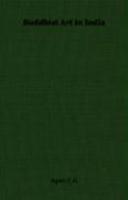
Book Summary
BUDDHIST ART IN INDIA C.G. Agnes PREFACE. THE first edition of Professor Albert Grunwedel's handbook on Buddhistische Kunst in Indian appeared in 1893, and the hope was expressed in the Journal of the Royal Asiatic Society that the work might appear in English, as" it ought to be in the hands of all antiquarians in India" Believing that so important a publication might, by a few additions, form a useful general guide to the BuddBist sculptures in the museums alike of India and Europe, I have prepared the present edition. Miss A. C. Gibson very kindly translated for me the first edition but by the time it was ready for the press, Prof. Griinwedel Jiad begun his second edition containing extensive additions and alterations. This involved delay and a revision of the whole MS Considerable additions have also been made to this translation, which have, partly at least, been indicated, and about fifty illustrations are added. The difficulties in interpreting the Gdndhra Buddhist sculptures arise chiefly from their fragmentary and unconnected condition. This has been lamentably increased by the ignorance or disregard of scientific methods on the part of the excavators of these remains. Monasteries and stfipas were dug into and demolished witho regard to what might be learnt in the process by modern me tEe more complete fragments only were saved, without note relative positions or any attempt to recover smaller chips by which they might have been pieced together, spoils were sent to various museums, often without intentionthe sites from which -they emanated. They were often further- cflltered at the will of excavators among different museums and private collections, and we cannot now placetogether the whole of the find from a single site, so as to compare the style, and still less the order of the reliefs while, of the more carefully surveyed, such plans and sections as were made are defective, and without explanatory descriptions. It is sincerely to be desired that, in future, the Government of India will prevent amateur excavationsj and make sure that their excavators really know how such work ought to be executed. With this manual in his hand, it is hoped, the visitor to ani collection of Buddhist sculptures will find it no difficult task to understand their character and meaning. Much still remains to be added to our information but it is only when complete delineation of the sculptures in various museums and private collections, on tin BarAhat fragments, and in the Ka/zheri, Elura, and other Bauddh. caves are made available, that we shall be able to interpret mor- fully the iconography of Buddhism. Towards this object som real progress has recently been made by the Government of Indi having ordered the photographing in detail of the SAficht relief and of the small collections of Gindhara sculptures in the Bomba and Madras museums. JAS. BURGESS. CONTENTS: CHAPTER I -INTRODUCTION. CHAPTER II.-EARLY INDIAN .STYLE. CHAPTER III.-THE GANDHiBA SCULP TUBES. 75-157. CHAPTER IV.-REPRESENTATION OP BUDDHA AND BODHISATTVA.
Book Details
| Book Name | Buddhist Art In India |
| Author | Agnes C. G. |
| Publisher | Hesperides Press (May 2006) |
| ISBN | 9781406712506 |
| Pages | 236 |
| Language | English |
| Price | 1330 |








